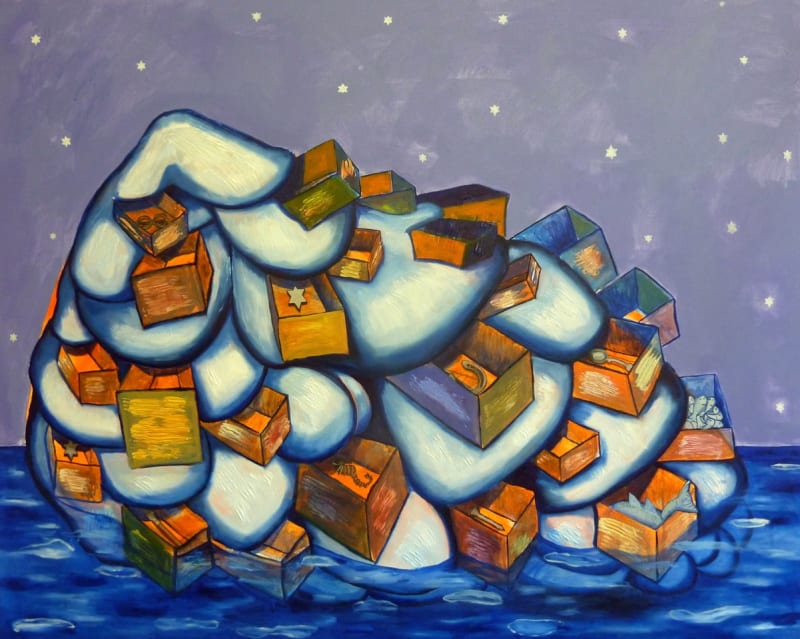In search of lost space
Imagine a world where post-Apocalyptic disaster meets history and myth, where dystopian catastrophe unveils itself in voluptuous, fleshy human-like forms. In the works of Celina Teague, figures hunch, crouched. They are covered in the minutiae and paraphernalia of everyday life like some strange Swiftian lost adventurer; Gulliver besieged in the land of the Lilliputs. Rolls of surreal flesh are emblazoned with gnashing teeth. Gaping orifices are set adrift in Technicolor sunsets and bruised blue waters. For its Frieze season exhibition this year, Kristin Hjellegjerde | ArtEco Gallery is proud to present In Search of Lost Space, a solo show of all new works by the London-based artist. This search explores how personal space - both physical and emotional - is affected by the radical changes and apocalyptic predictions of the greater world. Through her explorations of space and theory, Teague's works prompt us, through their distinctive abstraction and tangible textures, to consider our own sense of location within and without the structures of modern space.
Previous series, such as Neurotic Tectonic (2012), Sardonic Bucolic (2011) and Euphoric Metaphoric (2010) saw Teague explore allegorical tales, inspired by the likes of The Tower of Babel and Noah's Ark, as well as novels such as Brave New World and Animal Farm. In works such as Huxley's 'Brave New World' and Orwell's 'Animal Farm' Teague found a sense of dystopian catastrophe. This was echoed in her intricately-detailed canvases, imbuing them with a Bosch-like sense of anarchy and a Surrealist use of colour and form. She created alternate meta-universes that explored the big questions: What are we morphing into? What are the consequences?
And so, the title of this new exhibition was loosely inspired by Proust, "yet the idea of involuntary memory, so central to 'In Search of Lost Time', seems even more relevant the further along I have come in this exhibition," says Teague. "In this new series, there has been a break in my conceptual approach to painting." Teague has slowly moved away from more message-driven works, which were often connected to the places the artist had lived in and the incidents she had witnessed therein. "This new body of work, however, feels much more fluid and free; liberated by its not being too attached to a narrative," Teague continues. "I felt the need to reassess my approach to narrative and began exploring the tone of my work, which tended towards the grotesque and was bound tightly to the news stories I was reading. I wanted to explore these same global issues through a personal perspective."
The diversity of the paintings in In Search of Lost Space reflects Teague's freedom from this commitment to narrative. While some, such as Empty But Thriving, The Pursuit of Happiness and In Search of Lost Space are personal, and deeply connected to the female position, others, such as the triptych Passive Aggressive, Aggressive and Release and The Final Destination veer into abstraction, moving away from Teague's more figurative approach. Teague's new series retains the characteristic otherworldly quality of her older work, and as always, she has an eye for the absurd. And yet, here one finds a noticeably pared down quality: Her complex, meticulous works of the past have given way to paintings in which space is almost flattened - raw linen remains unpainted, and centralised objects suspended in a vast expanse. By contrast, her use of paint is markedly textured, combed through with forks and applied with knives and spoons.
There is something distinctly unsettling in the crouching figures hidden by shadow in Teague's canvases, yet there is something equally uplifting about works such as 'Empty but Thriving', in which large voluminous shapes give a sense of floating space. Here, amongst the curling tendrils and organic dollops of form lies a search for a singular truth that defines In Search of Lost Space. It may present a new direction for the artist, yet her core values, particularly those relating to the environment and to feminist concerns, remain. The freer stream-of-consciousness approach to her latest work invites audiences to witness a more introspective exploration of sights, textures and emotions brought to life on canvas; one in which the global and the personal, Teague seems to suggest, is one and the same.


